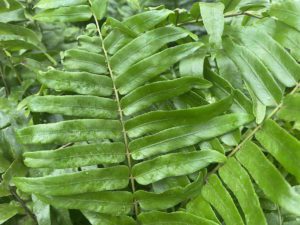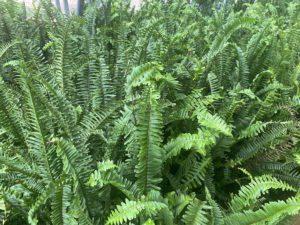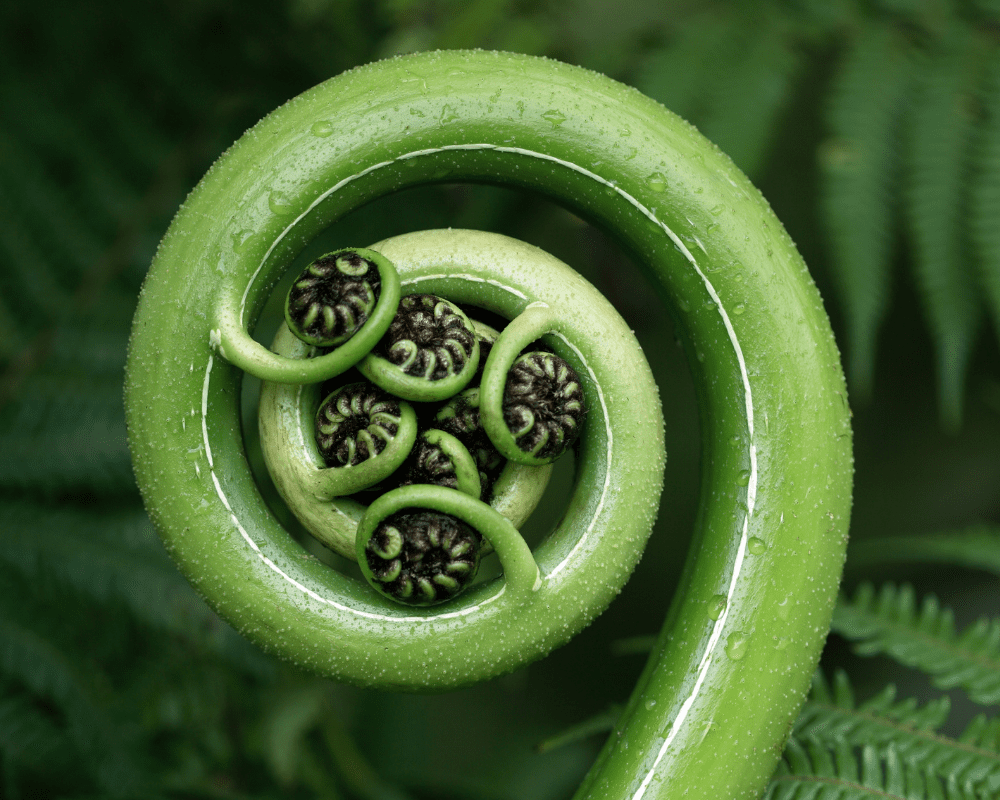

About Macho Ferns
Macho ferns are adaptable to both part sun and shade, We like them best in shadier areas because we think their leaves can get scorched by the rays. Make sure the part sun they receive is morning sun and not late afternoon. Macho ferns are evergreen which makes them a great plant to include in your permanent landscape. They’ll also live an average of 20 years. That’s a good investment! Give them a great start by planting them in landscape soil that has been amended with plenty of organic matter, or offer them a quality potting soil like Happy Frog from FoxFarm if they’ll be planted in a container.


About Kimberly Queen Ferns
Ferns often look stunning occupying space underneath a large shade tree, but they can also adapt to a little bit of sunshine if it’s offered in the mornings. Our favorite light to offer them is either morning sun and afternoon shade, or a continuous dapple of light all day long. By the way, Kimberly Queens make excellent houseplants. Indoors, they can adapt to low, medium or diffused bright light.
Kimberly Queen ferns are outstanding container options too, whether hanging from coco-lined baskets on the front porch or lining the deck under an overhang. Just remember that potted plants generally need more water than those planted in the landscape (especially during our hot summers).
Follow our same advice for soil types for Kimberly Queen ferns that we offered above about Macho ferns. While not particular to soil types, both of these ferns will perform their utmost best when you’ve offered a rich soil. PLEASE make sure that your soils and the location you plan to plant either Kimberly Queen ferns or Macho ferns in is well-draining. While they appreciate regular water, they will not tolerate wet feet; this will result in rootrot.

Macho and Kimberly Queen ferns grow in an upright and slightly arching form. Their stems are covered completely with the sword-like foliage from bottom to the top, which offers you a full and dense plant that looks great from all angles. I personally love how ferns add a great dose of texture to gardens and landscapes. Their foliage is strong but delicately refined. Plus, I’m not sure if you’ve ever seen the frond of a fern in the process of unfurling, but that alone is a reason enough to include a fern in your world.
Come take a look at our selection of Macho and Kimberly Queen ferns and see if one (or two) might be just what you need to go home with!
~The Happy Gardener, Lisa Mulroy


Are either or both of these germs deer resistant?
Like most ferns, both the Macho and Kimberly Queen ferns are generally not bothered by deer. Of course this will depend on the herd, and how hungry they are. They may take a nibble but will most likely move on. Hope this helps.
Beautiful description and photos.
Thank you Anne! I appreciate you taking the time to read and leave feedback.
Not only that! I bought a Macho and a Kimberly Queen Sunday at Rainbow Gardens. Now I’m clearing a bed by side fence for them. They will be bedded down with organic well-draining soil under the shade of a burr oak.
Do rabbits eat Kimberly and Macho ferns? We have a terrible problem planting anything that they won’t destroy.
Yes, although they typically go for other plants, rabbits could be taking a nibble of your ferns. They are difficult wildflife to control. Look along your fence lines if you have them, for holes and you may need to affix some wire grid to keep them out.
I live in zone 7 in SC. I currently have mine in large pots outside. will these survive outside in pots or do they need to be put in ground? too large to bring indoors.
Temperatures below 45°F will likely damage the plants. Can they be brought into a garage area?
I love my Macho Fern I got from Rainbow Gardens. It has been with me for 8 years and has grown to about 5 ft wide and 4ft high. It’s in a large ceramic, pretty blue pot. Every winter she comes inside. It takes two people to move. When I water it the leaves or branches actually move and lift up. The baby feelings are pretty awesome to see mature. This is really quite a spectacular plant. I’m so happy I got such a beautiful and healthy fern from RG.
Oh that is terrific to hear. It sure sounds like you’ve got yourself quite a specimen and it also sounds like it really likes you!
Do either of the ferns spread laterally like ground cover?
They both can spready fairly wide, and their roots spread laterally, but they don’t necessarily produce like a true groundcover would. Macho ferns may spread via stolons, which are stems that grow horizontally from the base of the plant and can root at the nodes, forming new plants. But this is generally in very warm or tropical areas.
Can you leave them in the ground in zone 7-9 Ct
A zone range of 7-9 is a big difference when it comes to cold hardiness. If you are closer to the zone 9 region, then you may have luck with leaving them in the ground as long as you take measures to offer winter protection when temps dip below 25°. They could still sustain some damage if left uncovered, but they will generally come back when warm weather returns. It will also depend on the duration of the low temperatures. A few hours makes a big difference than a few days at temps below 25°. Prep for winter by mulching around the base of the plants (but not piled up right next the crown), and if freezing temps are predicted, water thoroughly a day or two before it is set to arrive, then use your winter protection to cover plants, covering them before the sun goes down.